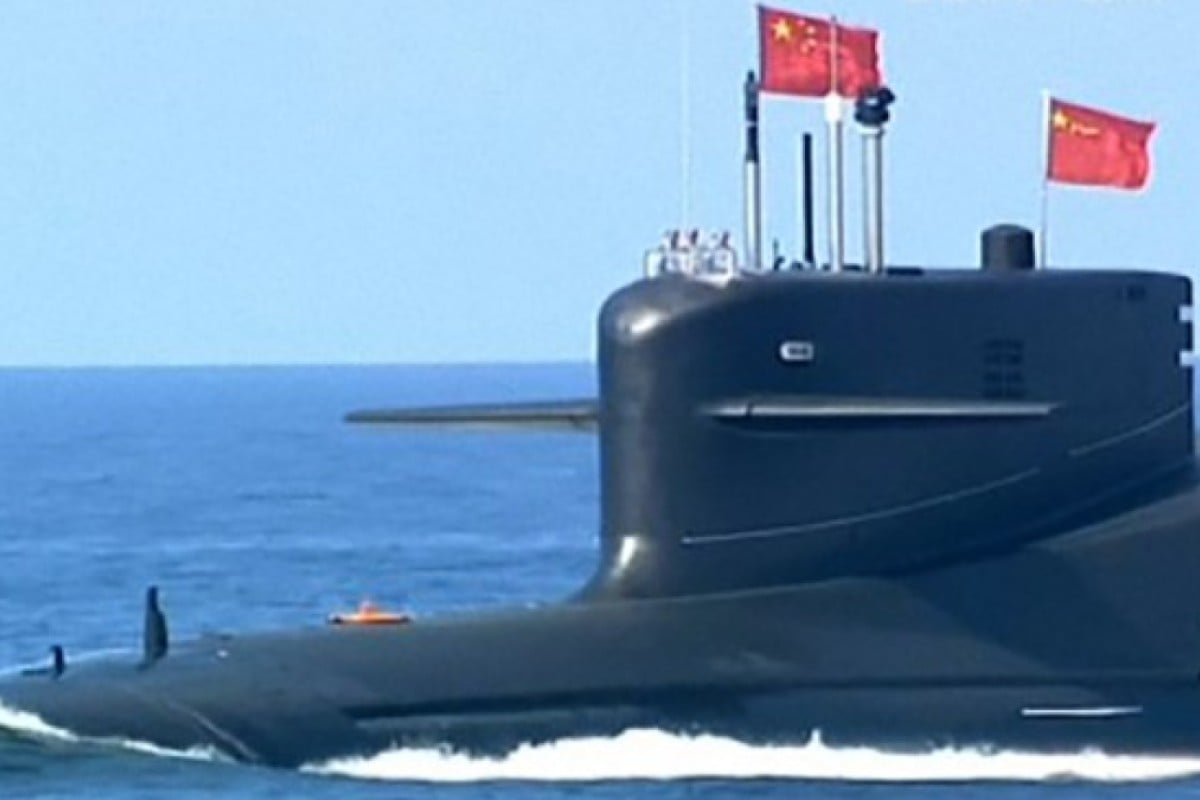
Chinese PLAN Type 094 Jin
class SSBN
Detecting a Submarine
Nicknamed the “Silent Service,” submarines are considered the most survivable nuclear weapons-delivery platform. They can stay submerged for weeks or even months at a time, and move relatively undetected while on patrol. The United States, Russia, China, North Korea, India, and Pakistan, the United Kingdom, and France have or are developing submarines capable of carrying nuclear weapons systems. An equal number of countries are developing and testing new nuclear-armed submarine-launched ballistic and cruise missiles.1 Such programs have already had a negative impact on stability in several areas of the globe. For example, the United States, its NATO allies, and Russia have ramped up Cold War-esque cat-and-mouse submarine hunts in the North Atlantic.2 Of additional concern is the submarine arms race occurring between India and Pakistan, as well as North Korea’s pursuit of diesel-electric ballistic missile submarine (SSB) capabilities.3
Given the integral deterrence role submarines play in the relationships between nuclear-armed countries, understanding the tools and technologies available for submarine monitoring is strategically important. Advancements in submarine detection have the potential to affect the survivability of submarines as nuclear delivery platforms. Submarine detection and monitoring was traditionally the exclusive domain of highly classified military units specializing in naval anti-submarine warfare (ASW). Military ASW employs technologies such as
- magnetic anomaly detectors (MAD), which detect
tiny disturbances to Earth’s magnetic field caused by metallic submarine
hulls, an accurate but short range sensor.
- passive and active sonar sensors that use sound generated by the target (passive) or active sound reflected by the target to detect objects underwater.
- radar and high-resolution satellite imagery to detect submarines when surfaced, or by wakes.
Recent advances in commercial tools and technologies now give open-source researchers some ability to monitor submarine fleets. With commercial satellite imagery, synthetic aperture radar (SAR), hydro-acoustic sensors, and even social media analysis, open-source researchers can better understand the size and composition of countries’ submarine fleets, monitor construction of submarines and submarine bases, and potentially learn about patrol patterns and behaviors.
What is sonar?
Sonar is an acronym for Sound Navigation and Ranging. There are two broad types of sonar in use:
- Passive Sonar. Passive sonar is a listening device that can determine the presence, characteristics and direction of marine noise sources. These sources may include biological noise (animal communication) and human sounds (eg ship or submarine noise). Passive sonar equipment is essentially an acoustic receiver which emits no sound.
- Active sonar. Active sonar is a technique that uses sound to determine relative positions of submerged objects (including submarines, fish, mines and wrecks of ships and aircraft) and the sea floor, by emitting a sound signal and listening for the echoes from the objects. Many different types of active sonar are used throughout the world's oceans by private, commercial and military vessels. These systems mirror the purpose of sonars used by some marine animals. Active sonar devices locate objects by the reflection of sound-waves and remain an important means of underwater detection and navigation.
The article "66 Years of Undersea Surveillance" by Captain Brian Taddiken, U.S.N. and Lieutenant Kirsten Krock, U.S. Navy, February 2021, Naval History Magazine,Volume 35, Number 1 https://www.usni.org/magazines/naval-history-magazine/2021/february/66-years-undersea-surveillance
This article discusses the history of the Sound Surveillance System (SOSUS), a network of hydrophones designed to detect and track Soviet submarines during the Cold War. The system was developed in the early 1950s and was continuously improved over the following decades, leading to numerous important intelligence successes, including the discovery of a Soviet submarine that had sunk in 1968. After the end of the Cold War, SOSUS was used for a variety of purposes, including scientific research and environmental monitoring. Today, the system has been largely replaced by more advanced technologies, but it remains an important part of the history of undersea surveillance.
The Sound Surveillance System (SOSUS) was initially developed in three phases, each of which involved the deployment of arrays of underwater hydrophones that were designed to detect and track Soviet submarines:
Phase I (1950s): The first phase of SOSUS involved the deployment of hydrophones in a few key locations, including the North Atlantic and the Mediterranean. The system was used to monitor the movement of Soviet submarines and to gather intelligence on Soviet military capabilities.
Phase II (1960s): The second phase of SOSUS involved the deployment of more hydrophones in additional locations, including the Arctic and Pacific Oceans. The system was also improved to make it more sensitive to the sounds of submarines, allowing for better detection and tracking.
Phase III (1970s): The third phase of SOSUS involved the development of new technologies, such as digital signal processing and acoustic correlation, which allowed for more accurate detection and tracking of submarines. The system was also expanded to include new locations, such as the Indian Ocean and the Mediterranean.
Over the years, SOSUS was replaced by newer and more advanced technologies, including the Integrated Undersea Surveillance System (IUSS) and the Surveillance Towed Array Sensor System (SURTASS). These systems use a combination of hydrophones, sonar, and other sensors to detect and track submarines and other undersea objects.
The Sound Surveillance System (SOSUS) was gradually decommissioned over a period of several years, beginning in the 1990s. The exact timeline varied depending on the location and type of listening station, as well as other factors such as changing geopolitical circumstances and technological advances.
The decommissioning of SOSUS was primarily driven by two factors. First, the end of the Cold War and the collapse of the Soviet Union reduced the perceived threat of Soviet submarine activity, which had been the primary target of the system. Second, advances in undersea surveillance technology, particularly the development of newer and more capable sonar systems, made some aspects of SOSUS obsolete.
In the United States, the last active SOSUS listening station was decommissioned in 1991. However, some portions of the system continued to be used for scientific research, particularly in the study of undersea earthquakes and other phenomena.
Despite the decommissioning of SOSUS, its legacy lives on in the Integrated Undersea Surveillance System (IUSS) and the Surveillance Towed Array Sensor System (SURTASS), which have continued to evolve and improve in the decades since SOSUS was developed. The lessons learned from SOSUS also continue to inform the development of new undersea surveillance technologies, as researchers seek to stay ahead of emerging threats and challenges in the undersea domain.
Today, undersea surveillance continues to be an important part of military and scientific operations. In addition to tracking submarines, these systems are used to monitor ocean currents, study marine life, and gather data on the ocean environment.
The development and deployment of the Sound Surveillance System (SOSUS) and its successors, the Integrated Undersea Surveillance System (IUSS) and the Surveillance Towed Array Sensor System (SURTASS), involved a number of participants and contractors. Here are some of the key players:
United States Navy: The development and operation of SOSUS, IUSS, and SURTASS were primarily the responsibility of the United States Navy. The Navy worked closely with other government agencies, including the Defense Advanced Research Projects Agency (DARPA) and the Central Intelligence Agency (CIA), to develop and deploy the systems.
Raytheon: Raytheon was one of the primary contractors involved in the development and deployment of SOSUS and its successors. The company provided a wide range of technologies, including hydrophones, signal processing equipment, and acoustic correlation software.
General Electric: General Electric was another major contractor involved in the development of SOSUS. The company provided a number of key technologies, including underwater amplifiers and analog-to-digital converters.
Woods Hole Oceanographic Institution: The Woods Hole Oceanographic Institution was responsible for the development of some of the key scientific technologies used in SOSUS, including the acoustic thermometry system, which was used to measure ocean temperatures.
Scientific Applications International Corporation (SAIC): SAIC was a contractor that played a key role in the development of IUSS and SURTASS. The company provided a wide range of technologies, including towed array sonar systems and acoustic sensors.
Other contractors and participants involved in the development and deployment of these systems included Teledyne Brown Engineering, Lockheed Martin, Northrop Grumman, and the Naval Research Laboratory, among others.
The development and deployment of the Sound Surveillance System (SOSUS) involved several of the United States' key allies. Here are some of the main countries that were involved:
Canada: Canada was a key partner in the development and deployment of SOSUS. Canadian researchers played a critical role in the early development of the system, and Canadian personnel were involved in the operation and maintenance of the system throughout its history. In addition, Canada provided several key listening stations, including those located in the Canadian Arctic.
United Kingdom: The United Kingdom was another important partner in the development and deployment of SOSUS. British personnel were involved in the operation and maintenance of the system, and the UK provided several key listening stations, including those located in the North Atlantic.
Norway: Norway provided a listening station for SOSUS in the Norwegian Sea, which was a critical location for monitoring Soviet submarine activity in the region.
Denmark: Denmark provided a listening station for SOSUS in the Greenland-Iceland-United Kingdom (GIUK) gap, which was a key location for monitoring Soviet submarines entering the North Atlantic.
In addition to these countries, several other US allies, including Japan, Germany, and the Netherlands, were involved in the development and deployment of SOSUS in various ways. The cooperation between the United States and its allies was essential to the success of the system, as it allowed for a wide range of listening stations to be deployed in strategic locations around the world.
Australia played a significant role in the development and operation of the Sound Surveillance System (SOSUS):
Scientific Contributions: Australian researchers made important contributions to the scientific research that underpinned SOSUS. For example, in the early 1960s, Australian scientists from the Commonwealth Scientific and Industrial Research Organisation (CSIRO) helped to develop a method for using acoustic signals to measure ocean temperatures. This technology, known as acoustic thermometry, was later used in SOSUS to measure the temperature of the ocean and help to locate and track submarines.
Technical Support: In addition to its scientific contributions, Australia provided technical support for SOSUS. Australian engineers helped to design and build some of the listening stations used in the system, and Australian technicians were involved in the installation, maintenance, and repair of the equipment.
Personnel: Australian personnel were also involved in the operation and maintenance of SOSUS. Australian Navy officers were trained to operate the equipment and monitor the data, and they worked alongside their American counterparts at various listening stations around the world.
Post-SOSUS Operations: After the decommissioning of SOSUS, Australia continued to participate in the United States' undersea surveillance efforts through its involvement in the successor systems, the Integrated Undersea Surveillance System (IUSS) and the Surveillance Towed Array Sensor System (SURTASS). Australian personnel have worked at IUSS and SURTASS facilities around the world, and Australian Navy ships have participated in joint operations with the US Navy to test and refine the systems.
Overall, Australia's contributions to SOSUS and its successors have been an important part of the US-Australian defense partnership, and have helped to strengthen the security of both countries.
Sound Surveillance System (SOSUS): The “Fish Hook” That Catches Chinese Submarines

Source Australian National University

A study by two Australian experts suggests the Chinese who are cornered. Desmond Ball and Richard Tanter suggest Japan and the US have China’s forces surrounded by trip-wires.Their book, The Tools of Owatatsumi, details the networks of undersea hydrophones and magnetic anomaly detectors that, combined with data collected by ground stations, patrol aircraft and satellites, make it virtually impossible for Chinese ships and submarines to break out into the wider ocean undetected. In effect, a line of sensors has been drawn in the sea.
Japan maintains a network of undersea hydrophone
arrays, connected to shore-stations which are typically equipped with
electronic intelligence (ELINT) systems, for monitoring, identifying and
tracking submarine and surface traffic in its internal straits and
surrounding seas. Some parts of this network are operated jointly with,
and are of crucial importance to, the US Navy. Japan’s
submarine detection capabilities would be of decisive advantage in any
submarine engagement.
Since the early 2000s, when PLAN submarine patrols have turned aggressive, the U.S. Navy and the Japan Maritime Self
Defense Force (JMSDF) began setting up a chain of fixed arrays to
monitor the movement of Chinese submarines in the East China Sea and
South China Sea. This resulted in the establishment of the “Fish Hook Undersea Defense Line”
in early 2005, stretching from Japan to Southeast Asia with key nodes
at Okinawa, Guam, and Taiwan. The system reportedly consists of two
separate networks of hydrophones, one stretching from Okinawa to
southern Kyushu, and the other from Okinawa to Taiwan.
The JMSDF and U.S. Navy personnel jointly manage the JMSDF Oceanographic Observation Centre in Okinawa, all the information is available to the U.S. Pacific Command,as the facility is under the operational control of the U.S. Navy.
This includes placing acoustic sensors in the deep ocean near US bases in the western Pacific and hydrophone networks along its own coast. Its growing ability to deny uninhibited American access to surface and aircraft military forces inside this island chain has shifted competition underwater where the US remains dominant. The resulting force structure that combines US and allied underwater, surface and aerial forces amounts to a giant fish hook that is intended to bait and capture Chinese naval and submarine forces – or at least make it impossible for Chinese forces to be sure of victory in a war in the western Pacific with the US.The combination oceanography and science-based engineering development can lead to extraordinary operational effectiveness of the US Navy.
Today, China is building an underwater Great Wall that reaches out to the first island chain that stretches from Japan to Taiwan to the Philippines to Indonesia, composed of its own sound surveillance system (SOSUS) nets and anti-submarine warfare (ASW) forces designed to deny the area above all to the US 7th Fleet, but also to other allied navies such as the Japanese Maritime Self Defense Force, Indian Navy or the Australian navy.
Target Acoustic Signature
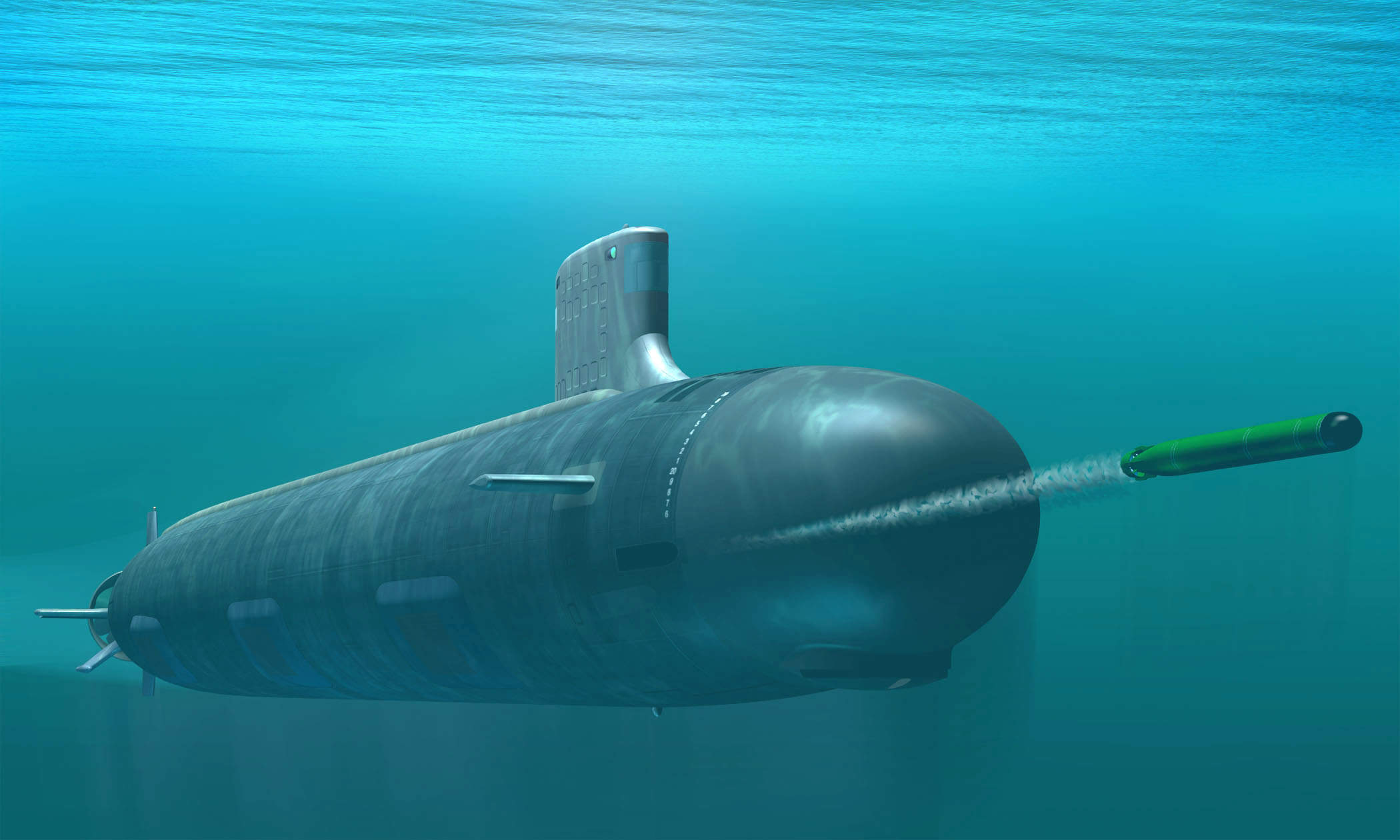
Acoustic signatures for US and Russian submarines. [The Russian "Lead Ship Keel - 4th Generation SSN became the Yasen class. Of US subs "688" is Los Angeles SSN, 688I Improved Los Angeles, SSN-21 Seawolf class, NSSN Virginia class (Image Credit: Federation of American Scientists.)]
---
Stealth, first and foremost, is the most critical aspect of an attack submarine as it determines the submarine's relative survivability and is a prerequisite to the submarine acting as an effective area denial, power projection, or ISR platform.
Quieting technology has progressed steadily since the end of the Second World War with the advent of improved anechoic tiles, integrated electric drive systems (over mechanical), X-shaped stern control surfaces, pump jet propulsion systems (over conventional propellers), AIP technology, [elastic or dampner mounts for engines and other moving parts] etc. The acoustic signature of a submarine, which is measured in decibels, is an indicator of a submarine's relative detectability to passive sonar systems. The following is from the article "China's Anti Access Strategy: Submarine Force - Part I":
A decibel is "a unit used to measure the intensity of a sound or the power level of an electrical signal by comparing it with a given level on a logarithmic scale" (American English in Oxford dictionary, 2013). Decibels do not scale linearly. A 3db change is signifies a doubling power and a change of 10 db signifies the power increasing by a factor of ten. Therefore, the 636 Kilo class with an acoustic signature of 105 decibels is 10 times as loud as the 95 decibel acoustic signature of the Virginia class submarine.
The United States is widely recognized as fielding the most capable and stealthiest submarines with the Virginia and Seawolf class submarines. The following is from Chinese Evaluations of the U.S. Navy Submarine Force by Andrew S. Erickson, William Murray, and Lyle Goldstein:
"Chinese observers are intensely interested in and closely follow other modern U.S. nuclear submarines, including the [Seawolf class SSN-21 USS Jimmy Carter, Seawolf}, and [Virginia class USS Hawaii (SSN-776)]. Highly detailed, full-page color photos of Seawolf- and Virginia-class submarines appear in China’s most prominent naval journals. These photos are usually accompanied by articles that imply an advanced state of technology and advanced acoustic quieting...
Chinese authors believe Seawolf possesses 'beyond-first-class performance' and is regarded as the most sophisticated and lethal submarine yet to go to sea, despite its 'tortuous development history'. The Chinese also respect Virginia-class submarines for their advanced technology and quietness...'Its acoustic signature is lower than that of the improved model of Russia’s Akula-class attack submarine and Russia’s fourth-generation attack submarine that will hereafter be in active service'.
Another analyst, in discussing the Virginia class’s acoustic achievements, reports, 'The Virginia-class has been called the world’s quietest submarine,’ with a cruising sound level that is only '1/10 that emitted by a Los Angeles class boat pierside'. The construction techniques used to build Virginia and its sister ships also evoke respect'"
Submarine Source |
Decibels |
Ocean background noise [1] |
90 decibels |
SSN-21 Seawolf class SSN |
95 decibels |
Virginia class SSN |
95 decibels |
Russian Improved 636 Kilo class SSK |
105 decibels |
Akula class SSN |
110 decibels |
Improved Los Angeles SSN |
105 - 110 decibels |
Type 093 Shang SSN |
110 decibels |
Type 094 Jin SSBN [2] |
120 decibels |
[1]. Regarding "Ocean background noise" or ambient noise - see Figure 1. at http://www.nature.com/articles/srep00437 for noise levels (at sea) from natural/biological and Shipping Noise - yielding at least 90 decibels in 2001 and 2007. The 90 decibels appears more an average than a constant noise level everywhere. So submarines that can be very quiet in quiet ambient sea conditions can use their Passive Sonars to hear much more enemy activity over longer distances.
[2]. China’s Type 094 Jin SSBN is the loudest, too loud to go on regular patrol. In 2009, USN ONI listed the Type 094 as being slightly noisier than Project 667BDR (NATO reporting name Delta III) from the late-1970s, some of which were in service through 2015 with the Russian navy.]
Relative detectability of Russian and Chinese diesel and nuclear powered submarines. Image Credit: US Office of Naval Intelligence, 2009.
---
With the focus of future warfare planning once again addressing a return to peer or near-peer military adversaries, technologies such as stealth, via low acoustic signature, are a primary concern for the Royal Australian Navy. In support of this, the Defence and Science Technology Group (DST) is working with industry to develop a new tool that will make building this capability into programmes including the Sea 1000 Future Submarine programme and the SEA 5000 Future Frigate programme, more effective and efficient than ever before.
Under SEA 1000, Australia is procuring 12 new submarines to enter service within the early 2030s, while under SEA 5000, Australia is seeking nine anti-submarine warfare frigates. Both programmes require vessels to be able to operate with high levels of stealth, part of which relies on a low acoustic signature.
AusRAT
The tool, called the Australian Rapid Assessment Tool (AusRAT), assists in modelling the acoustic signatures for all classes of naval vessels. The acoustic signature – the noise and vibrations a vessel and its on-board equipment and systems make in the water – is a key concern for navies aiming to build low visibility vessels. An adversary looking to find, track and identify vessels must only use equipment to ‘listen’ for acoustic noise in the water in order to track the location and movement of its enemy’s vessels. As a result, acoustic signatures must be kept as low as possible in order to avoid detection.
In order to do this from the outset – before the vessel has even been built – the AusRAT project is developing a tool which will provide the ability to predict the acoustic signature of a vessel while it is still in the design and construction stage.
AusRAT can be applied to any naval platform, including both surface ships and submarines. By predicting acoustic signature at the concept and preliminary design stages, when only limited information is known and fast turnaround of results is needed in order to assess different configurations, the right result can be found before programmes are deep into the build stage and investment has been committed.
The tool can also be used to provide updated predictions during the detailed design and build phases; and to investigate the potential impact of components not meeting their noise budget. It provides approximate analytical models that allow a whole-boat radiated noise estimate to be run in just a few minutes.
The DST and industry team have also developed a flexible and extendable software architecture that allows for seamless integration of new acoustic signature models.
Heggernes testing
The DST believes that the AusRAT tool provides a big advantage compared to other commercially available modelling tools which require detailed information to develop models and can take significantly longer to produce results. However, there certainly remains a place for acoustic measurement solutions that test the vessels once they are built and as they move through their service life, undergoing refit and upgrades, to ensure their noise levels do not deviate from stipulated limits and remain in accordance with requirements.
One of the few facilities in the world able to study acoustic noise is the acoustic range at Heggernes in Norway, which tests NATO military vessels.
The range performs static and dynamic testing in order to characterize the acoustic signature of NATO submarines and surface vessels, supported by the Brüel & Kjær Underwater Acoustic Ranging System (UARS). UARS provides an integrated solution supporting navies with the task of managing and maintaining the acoustic stealth of their submarine and surface fleet.
Static ranging is carried out by mooring the vessel being tested between three buoys, with two underwater acoustic transducers – called hydrophones – located on the sea bed on each side of the vessel, around 50m below the surface and connected to the range house by cables. Each on-board system is then turned on one at a time and the noise they produce is measured. Dynamic ranging is carried out while the vessel is on the move, with the generated noise measured as it passes specific points on the course.
Keeping one step ahead
L3 Oceana also develops solutions to measure and communicate data through water, including its Submarine Acoustic signature measurement Range (SAR). SAR is an ultra-low noise acoustic measurement range that incorporates co-operative tracking and highly automated data analysis and management software. It measures the acoustic signatures of submarines and surface vessels using submerged hydrophone array and electronics.
However, the development of technologies to out-stealth adversaries remains a game of one-upmanship as does all types of electronic warfare. With the US military’s research arm, the Defense Advanced Research Projects Agency (DARPA) delving into new realms of submarine hunting technologies under its Anti-Submarine Warfare (ASW) Continuous Trail Unmanned Vessel (ACTUV) programme, even the quietist diesel electric submarines will no longer be immune to detection.
The aim of the programme is to demonstrate the capability of the ACTUV system to use its unique characteristics to employ non-conventional sensor technologies that achieve robust continuous track of the quietest submarine targets over their entire operating envelope.
As a result, systems such as AusRAT will become ever more important and valuable as a development tool. Knowing what the answers are before a hull has been laid or an engine procured will allow signature technology development to continue to outpace detection technologies.
Mobile Passive Sonar Systems
Mobile passive sonar systems provide deployable surveillance to hot
spots and gaps in the fixed surveillance network coverage. Tactical Navy
surface ships are poor platforms for passive sonar because of their
needed high speed and maneuverability which generates high self noise
masking the small signals which a passive sonar seeks to detect, hence
hull mounted sonars are usually active. Passive towed array VDS can be
used to avoid hull noise, but constrains speed and maneuverability.
Submarines and LUUV are optimal passive sonar platforms and frequently
mount a multimode spherical array in the bow, as well as a towed line
array.
The original SURTASS system was developed during the Cold War. It comprises ship-towed passive and active sonar arrays and provides “long-range detection [of submarines] and cueing for tactical weapons platforms or other vessels of interest,” according to the U.S. Navy.
The U.S. Navy’s SURTASS was updated in the late 1980s to include a low-frequency active (LFA) sonar capability, which “provides an active adjunct capability for IUSS [Integrated Underwater Surveillance System] passive and tactical sensors to assist in countering the quieter diesel and nuclear threats of the 1990s and beyond,” according to the service. The LFA is especially useful for detecting slow-moving quiet threats in littoral waters.
Originally fielded by the U.S. Navy on its Stalwart class ocean surveillance ships, SURTASS was then switched to multiple different catamaran-style vessels with the introduction of the LFA upgrade. After the end of the Cold War, the SURTASS system became a much lower priority and, today, the SURTASS towed array is found only on the USNS Impeccable and the four ships in the Victorious class, although it has also been exported to Japan, for use on the three Hibiki class ocean surveillance ships. Australia will be only the second foreign customer for SURTASS, further emphasizing the significance of these plans.
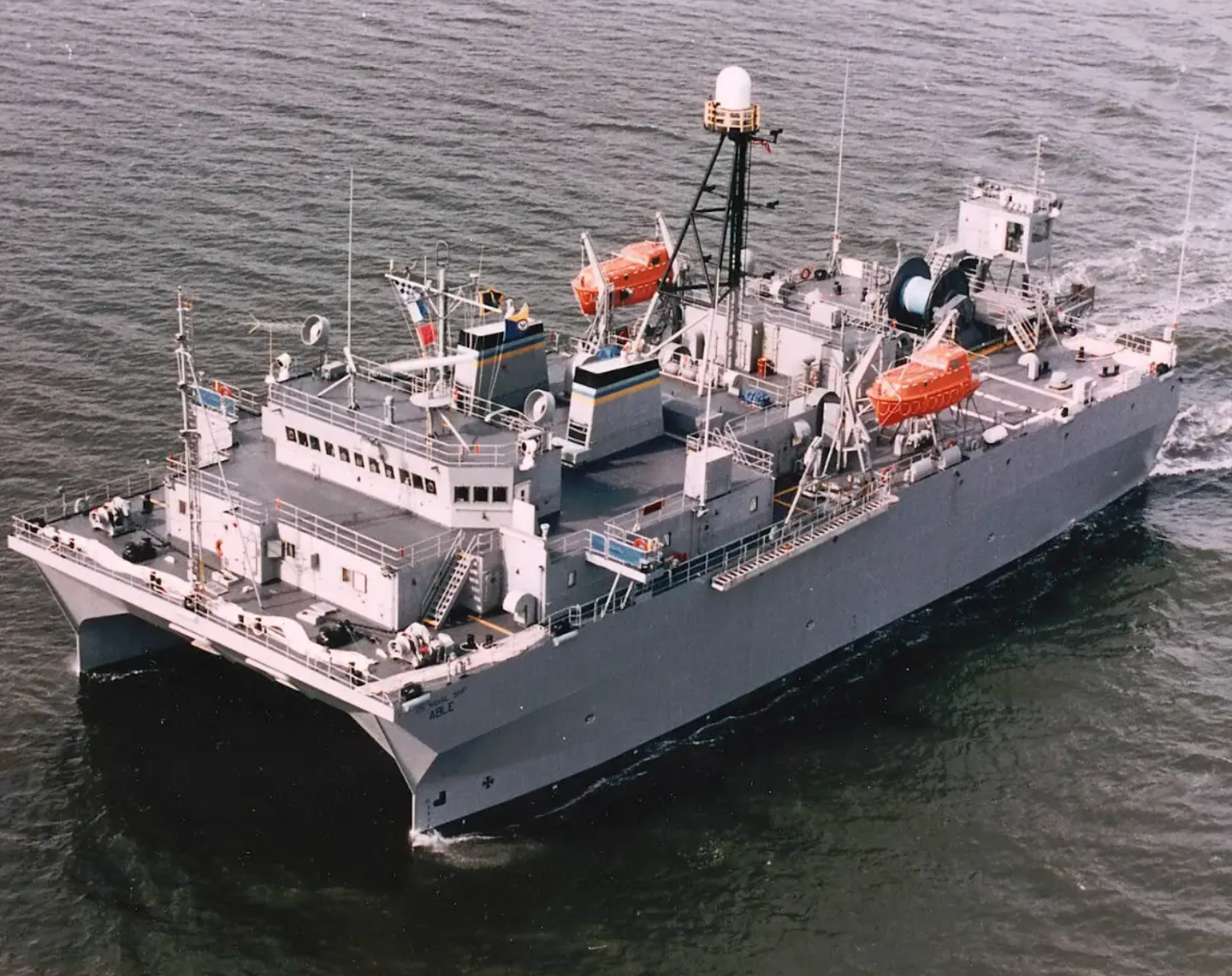
Compared to SURTASS, the SURTASS-E system, the development of which began in 2017, does not feature an active sonar capability, although it offers greater flexibility thanks to its containerized, modular nature. As mentioned, we don’t yet know what ships the systems will be installed in and whether they will be fitted to existing ships or a new class of vessels. Bearing in mind the kinds of surveillance ships that are outfitted with the original SURTASS, one candidate might be the RAN’s two remaining Paluma class of hydrographic survey motor launches. These share the catamaran hull form also found on the USNS Impeccable and the Victorious and Hibiki classes.
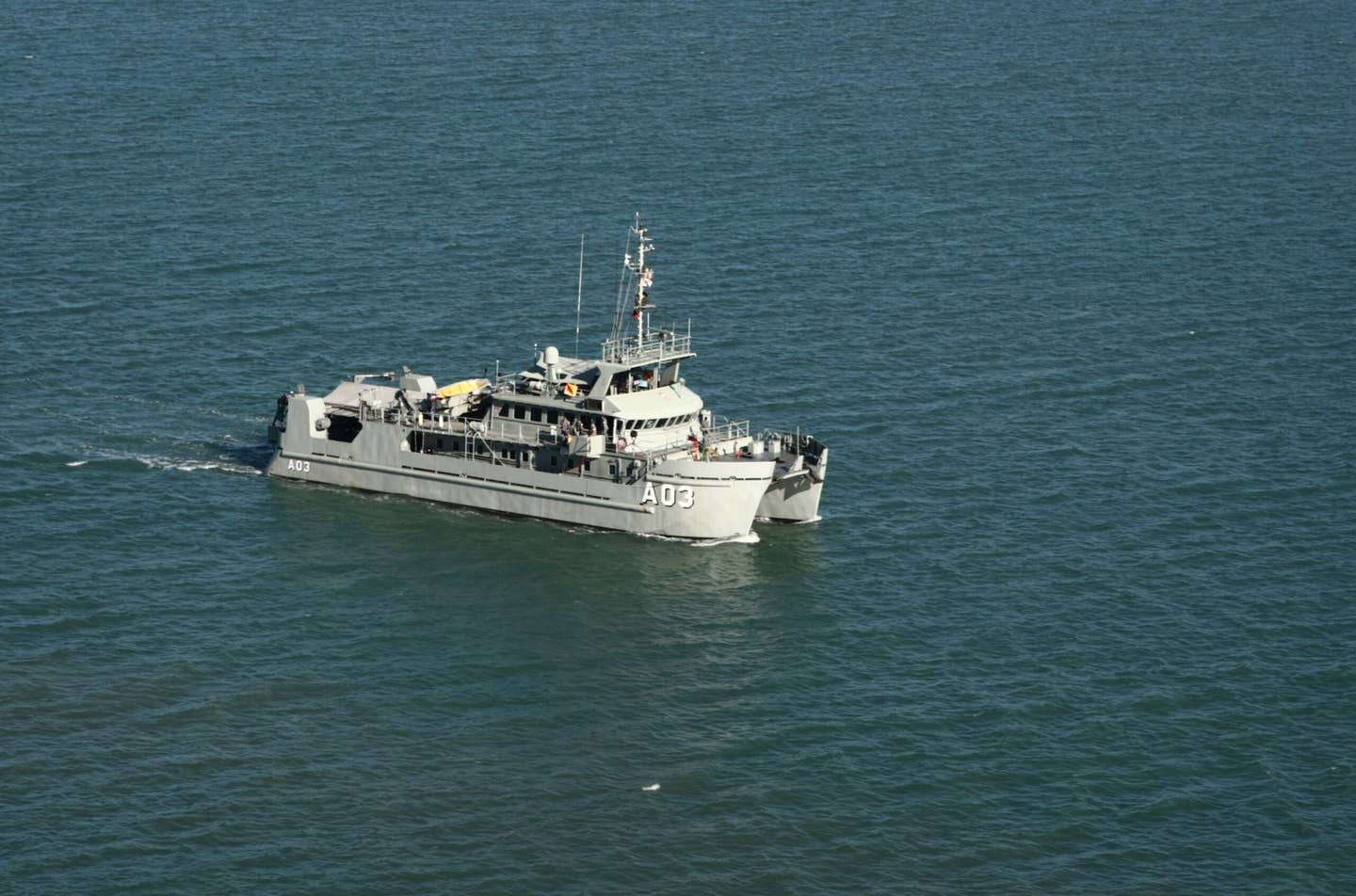
Broadband display. The output of the beamforming processor
is displayed as a bearing time history (BTH):
Figure 10. Bearing time history (BTH) display.
The newest information is at the top of the display. The beamwidth of the system determines how accurately the bearing can be measured by such a display. A common beamwidth is about 5o. The total amount of time displayed from top to bottom can be controlled (to some extent). A quickly updating display that only kept information for a few minutes would be useful for close contacts whose bearings are changing rapidly. On the other hand, a long tie history is more useful for detecting long range contacts, whose bearings are only changing slowly.
Transient Signal Detection in Underwater Sound Using Wavelets
Trevor C. Bailey, Theofanis Sapatinas, Kenneth J. Powell and Wojtek J. Krzanowski published an article on using the wavelet method for detecting transient features
in sound recordings that contain interference or distortion. In this
particular case, the data are various types of underwater sounds, and
the objective is to detect intermittent departures (potential "signals")
from the background sound environment in the data ("noise"), where the
latter may itself be evolving and changing over time. They develop an
adaptive model of the background interference, using recursive density
estimation of the joint distribution of certain summary features of its
wavelet decomposition. Observations considered to be outliers from this
density estimate at any time are then flagged as potential "signals."
The performance of our method is illustrated on artificial data, where a
known "signal" is contaminated with simulated underwater "noise" using a
range of different signal-to-noise ratios, and a "baseline" comparison
is made with results obtained from a relatively unsophisticated, but
commonly used, time-frequency approach. A similar comparison is then
reported in relation to the more significant problem of detecting
various types of dolphin sound in real conditions. This process could also be used to detect maneuvers, machinery mode change, weapon launch, etc.
Frequency Analyzer.
The frequency analyzer breaks
the signal into separate frequencies typically using Fourier analysis. This is the spectrum of
the signal. For processing purposes, the frequencies are divided
into small bands known as frequency bins. The width of
each bin is called the analysis bandwidth which is inversely proportional to the integration time.
Figure 11. Frequency analysis.
Sonar systems can gain considerable signal-to-noise improvements
by matching the analysis bandwidth to the bandwidth of narrowband
sources. The way to illustrate this is by two counter examples.
If the signal processing bandwidth is too wide, then noise from
the part of the spectrum beyond the signal is let in and the SNR
is degraded. If the bandwidth is too narrow, then part of the
signal is excluded, also reducing the SNR. It should be obvious
now that the best situation occurs when the bandwidth exactly
matches the signal. This is possible when the characteristics
of the signal are well known, which they are for most targets.
The frequency analyzer separates (filters) the signal
into discrete bins, inside of which the SNR is maximized. The
frequency content of the signals from a target information provides
vital information about its identity and operation. These frequencies
are also subject to the Doppler shift, just like radar, are therefore
can provide information about the range rate. This requires that
the original frequency be known exactly, which is generally not
the case. However, many important facts can be inferred by the
changes in the received frequency over time.
Narrowband Display. For a particular beam, the time history of
the frequency is called a waterfall display.
Figure 12. Waterfall display.
This can be used to gain additional information from a contact
which is already being tracked by another system. In order to
search for contacts on the basis of narrowband information alone
requires a different type of display. One possibility is to simultaneously
display several different beams, each showing a mini-waterfall
display, which are called grams.
Figure 13. Narrowband grams.
These are quite useful, but require great concentration on the
part of the operator because there is more information displayed
at any one time. Many systems require the operator to systematically
search the entire field-of-view, looking at only a few beams at
a time.
Towed Array Sonar Systems (TASS) and SURTASS
A towed array is a linear array of hydrophones. The array
is towed behind the ship on a cable of variable scope like a VDS.
However, it is strictly a passive system.
Figure 14. Towed array.
The signal from the array is led to a beamforming processor which
creates several narrow beams. Because the array is linear, there
is no vertical directionality. This causes two problems. The
first problem occurs when there is bottom bounce propagation.
In this case, the direction of the source is not known without
further analysis.
The second problem is an ambiguity in relative bearing.
The linear array cannot distinguish signals on the left from
those on the right.
Figure 15. Bearing ambiguity
with towed array.
The problem of bearing ambiguity can be resolved by maneuvering
the ship. When contact is regained, there will again be two ambiguous
bearings, but only one of which will match the previous case (assuming
that the target hasn't moved much between legs).
Example: a towed array contact is gained at relative bearing
030/330 R, while the ship is on course 045 T. The ship changes
course to 135 T and regains the contact at 060/300 R. Find the
true bearing to the actual contact. First leg: the contact is at either 015 T or 075 T (045 030).
Second leg: the contact is at either 075 T or 195 T (135 060)
; therefore the actual contact is at 075 T.
Broadband beamforming of multiplet line arrays eliminating port/starboard ambiguity
Product beamforming and nested array in tandem for enhanced sonar performance
High-performance sonar systems mostly combine a large sensor array and an efficient beamformer for enhancing the overall detection capabilities and estimation of Direction of Arrival (DoA) of the acoustic signal released from underwater targets in the ocean. The array geometry and the number of elements have direct influences on the beam width and the signal to noise ratio but increase the complexity in terms of hardware and computational requirement. Even when such hardware complexities are accommodated in complex systems, the performance of such systems is often par below its expected level because of the limitations of the beamformer.Surveillance Towed Array Sensor System (SURTASS) Low Frequency Active (LFA) Sonar
SURTASS LFA sonar is a long range surveillance sonar that is necessary for the U.S. Navy to meet its anti-submarine warfare and national security mission. SURTASS LFA sonar systems are operated onboard U.S. Navy surveillance ships to provide improved capability to detect quieter and harder-to-find foreign submarines such as 4th generation Russian Submarines at greater distances than can be done using passive alone. These underwater sonar systems transmit low-frequency acoustic signals between 100 and 500 Hertz and include both active and passive components.

Active sonar transmitter below a surface ship sends out pulses of sound
that bounce off a submarine underwater and are detected as returning
echoes. Courtesy of SURTASS LFA EIS, www.surtass-lfa-eis.com.
The Surveillance Towed Array Sensor System Low Frequency Active (SURTASS LFA) sonar system is an antisubmarine warfare device designed by the US Navy. The system has both passive and active components. The passive part of the system is called SURTASS. It consists of a long array of hydrophones to listen for underwater sounds, particularly submarines. When the submarine is too quiet to be heard by SURTASS, LFA sonar is employed. LFA is a set of acoustic transmitters suspended on a cable beneath a ship. These transmitters produce sound between 100 and 500 Hz with a source level of approximately 215 underwater dB at 1 meter. The combined system has an effective source level from 230 to 240 underwater dB at 1 meter. These sound pulses reflect off submerged objects and are heard on SURTASS. Using sounds with this intensity and frequency allows for a long detection range. The objective of this system is to locate submarines far enough away so that they are not within firing range of the ship or any other ships it may be protecting.
There has been much concern about the potential risks of SURTASS LFA to marine animals and divers. LFA has 18 transmitters, each with a source level of approximately 215 underwater dB. Sounds received from these transmitters are potentially threatening to animals that rely on sound for survival. The Navy has spent over $16 million dollars conducting scientific research on the potential effects of LFA on marine mammals and developing an Environmental Impact Statement (EIS), including a marine mammal mitigation system. The Navy has put restrictions on the use of SURTASS LFA so that received levels would be below 180 underwater dB within 22 km (12 nm) of all coastlines and in offshore biologically important areas. To see further information regarding the marine mammal research of SURTASS LFA and the operation systems of SURTASS LFA go to Why the United States Needs SURTASS LFA and NEPA SURTASS LFA Sonar Scientific Research.
Maranda, B.H. (2008). Passive Sonar.
In: Havelock, D., Kuwano, S., Vorländer, M. (eds)
Handbook of Signal Processing in Acoustics. Springer, New York, NY.
https://doi.org/10.1007/978-0-387-30441-0_97
Prospects for game-changers in submarine-detection technology
Australia Getting U.S. Containerized Submarine-Tracking Sonar System
Australia is set to become the latest customer for the U.S.-developed Surveillance Towed Array Sensor System–Expeditionary, or SURTASS-E, a passive submarine detection system. The move to acquire SURTASS-E is the latest step in Australia’s ambitious undersea warfare modernization effort, the flagship program of which will see the Royal Australian Navy, or RAN, introduce its first nuclear-powered, conventionally armed submarines, against the backdrop of increasing concerns about the Chinese submarine threat.
The U.S. Defense Security Cooperation Agency (DSCA) yesterday announced that the State Department has approved a possible Foreign Military Sale to Australia of an undisclosed number of SURTASS-E systems, at an estimated total cost of $207 million.

So far, it’s unclear what specific ships the systems will be installed in, with the DSCA statement mentioning only that they are intended for “Vessels of Opportunity (VOO).” However, SURTASS-E was always intended to be packaged in standardized shipping containers, or ISO-Vans, which can be readily installed on various suitable ships, as required.
As well as the SURTASS-E mission systems themselves, the declared price tag also includes a shore-processing mission system, a spare SURTASS passive acoustic array, containers, communications parts and support equipment, software, publications, training, U.S. government and contractor engineering support, and other related logistics and program support elements. Lockheed Martin will be the primary contractor for the program.
Work on SURTASS-E was carried out under a so-called Rapid Prototyping, Experimentation, and Demonstration, or RPED, effort, which led to a first-ever operational patrol of an appropriately equipped vessel in the Atlantic in 2019.
Since work on the SURTASS-E began, the U.S. Navy has also embarked on developing a new, more rapidly deployable, fixed, persistent, deep-water active anti-submarine surveillance system. This is known as the Affordable Mobile Anti-Submarine Warfare Surveillance System, or AMASS, and you can read more about it here.
For the Royal Australian Navy, or RAN, the SURTASS-E promises to enhance the service’s ability to detect and track submarines, also at extended ranges, including the advanced new submarine designs coming from China.
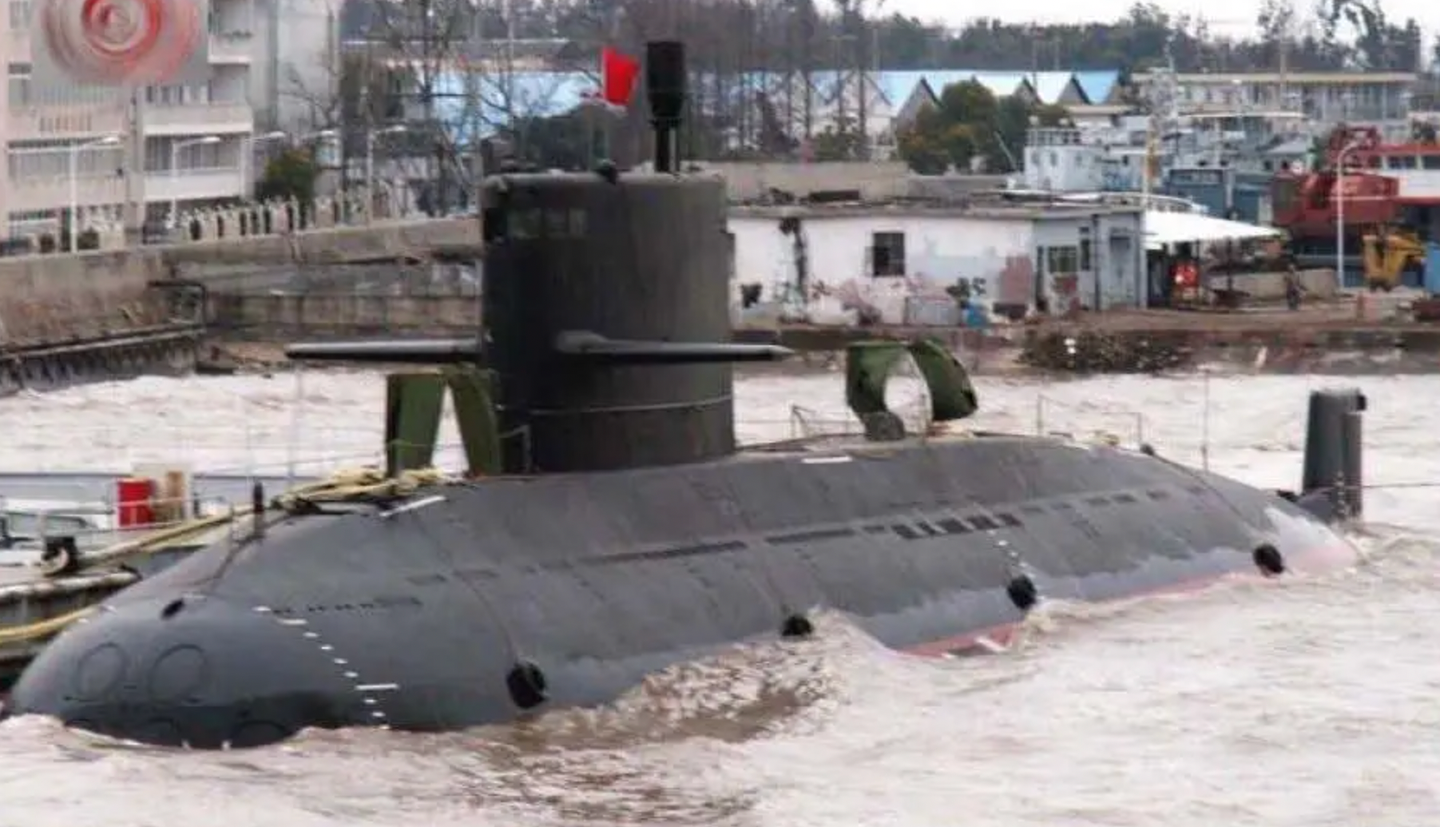
“This proposed sale will support the foreign policy and national security objectives of the United States,” the DSCA declares. “Australia is one of our most important allies in the Western Pacific. The strategic location of this political and economic power contributes significantly to ensuring peace and economic stability in the region. It is vital to the U.S. national interest to assist our ally in developing and maintaining a strong and ready self-defense capability.”
More specifically, the DCSA states that the proposed sale of SURTASS-E “will improve Australia’s capability to meet current and future maritime threats by providing tactical platforms with the detection and cueing of enemy submarines. The ability to provide acoustic wide-area surveillance and generate indications and warnings to Australian commands will significantly improve shared maritime security. Australia will have no difficulty absorbing this equipment into its armed forces.”
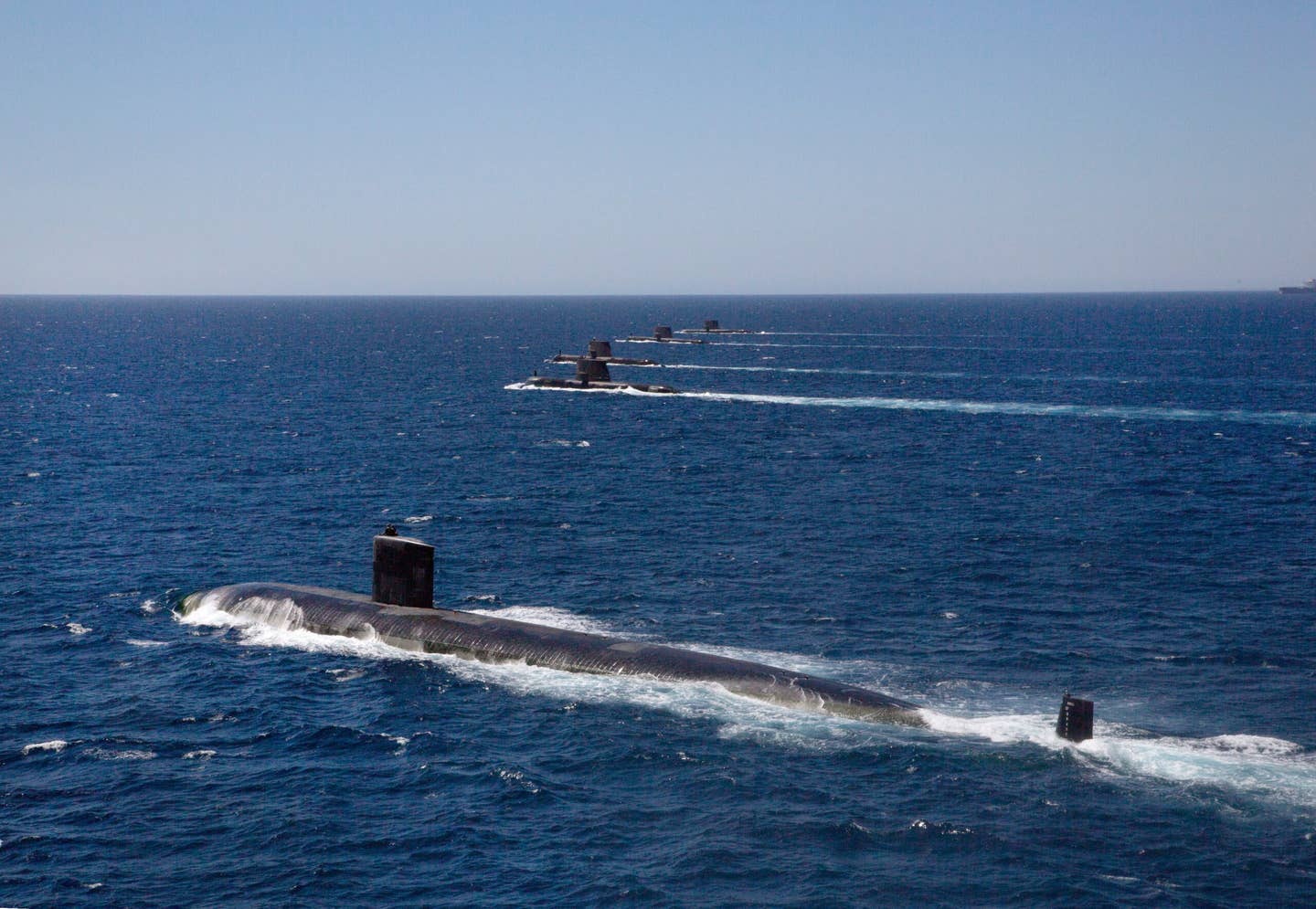
The fact that the planned Australian deal will bring more SURTASS systems to the Asia Pacific region will clearly bring benefits to U.S. and other allied anti-submarine capabilities, too, while the ability to potentially deploy these systems on different vessels will only help with coverage and being able to deploy them with greater flexibility — and unpredictability.
For Australia, the threat posed by Chinese submarines, and the expanding size and capabilities of the People’s Liberation Army Navy (PLAN), more generally, is at the center of current military modernization initiatives.
The nature of the Chinese maritime threat to Australia has been made more manifest in recent times, with high-profile incidents both close to the Australian coast and in the hotly contested South China Sea.
In May last year, Australian officials reacted angrily to the appearance of a PLAN intelligence-gathering vessel off the coast of Australia. Although the Type 815 Dongdiao spy ship Haiwangxing apparently remained in international waters throughout the incident, Australia’s then Defense Minister Peter Dutton described the actions of the PLAN vessel as an “aggressive act.”

Significantly, the route of the Haiwangxing down Australia’s west coast seems to have brought it close to the Naval Communication Station Harold E. Holt, or HEHCS, a joint Australian and U.S. naval communication station. This highly sensitive installation provides very low frequency (VLF) radio communications that are vital for operations by Australian, U.S., and allied submarines operating in the western Pacific Ocean and the eastern Indian Ocean.
A month later, in June 2022, a Royal Australian Air Force (RAAF) P-8A was damaged by countermeasures launched by a Chinese J-16 Flanker fighter jet over the South China Sea, according to the Australian Department of Defense. The department accused the crew of the J-16 of conducting a “dangerous maneuver” while the P-8 was operating over international waters. China’s Ministry of National Defense responded by saying the P-8 had “seriously threatened China’s sovereignty and security and the countermeasures taken by the Chinese military [were] professional, safe, reasonable, and legitimate.”
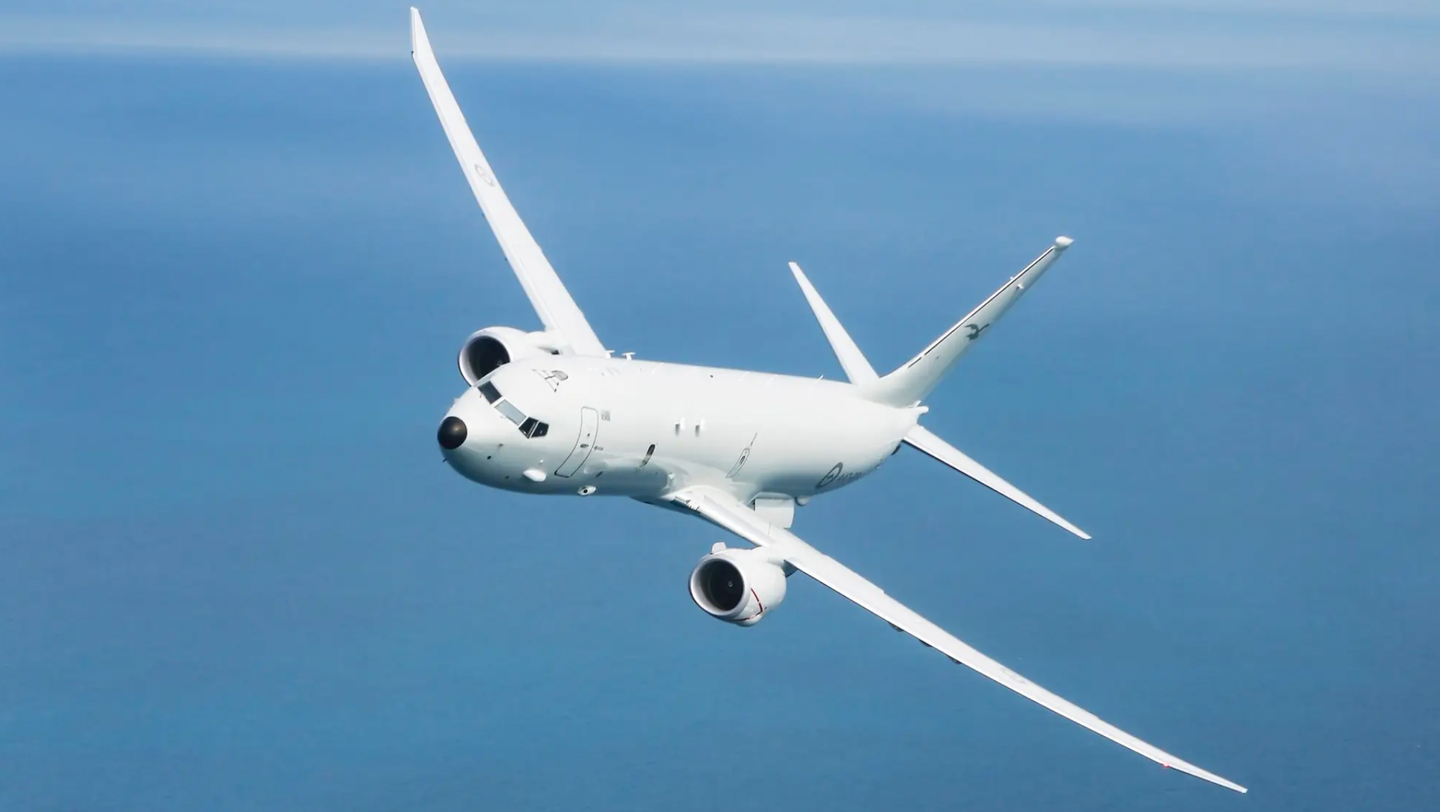
These episodes bring into sharper focus the military and strategic challenges to Australia posed by China. As part of a more robust maritime posture, the Australian military is set to work increasingly closely with the United States and the United Kingdom under the AUKUS agreement, as well as to introduce the aforementioned nuclear-powered submarines.
Australian officials have specifically pointed to the growing maritime challenge from China as the driving force behind the nuclear-powered submarine program. Last year, Australia’s then Defense Minister Peter Dutton said that the RAN’s current “diesel-electric submarines would not be able to compete against the Chinese in the South China Sea beyond 2035.”
As well as these submarines, Australia is also working on developing extra-large drone submarines and, late last year, unveiled the Ghost Shark testbed that will help inform these future designs. Under the overarching Extra Large Autonomous Undersea Vehicle (XL-AUV) program, Australia is seeking to rapidly produce an affordable, autonomous, long-endurance drone that can be tailored for a variety of military and non-military missions. Ultimately, drone submarines are expected to undertake “dull, dirty, and dangerous missions” in support of crewed submarines.
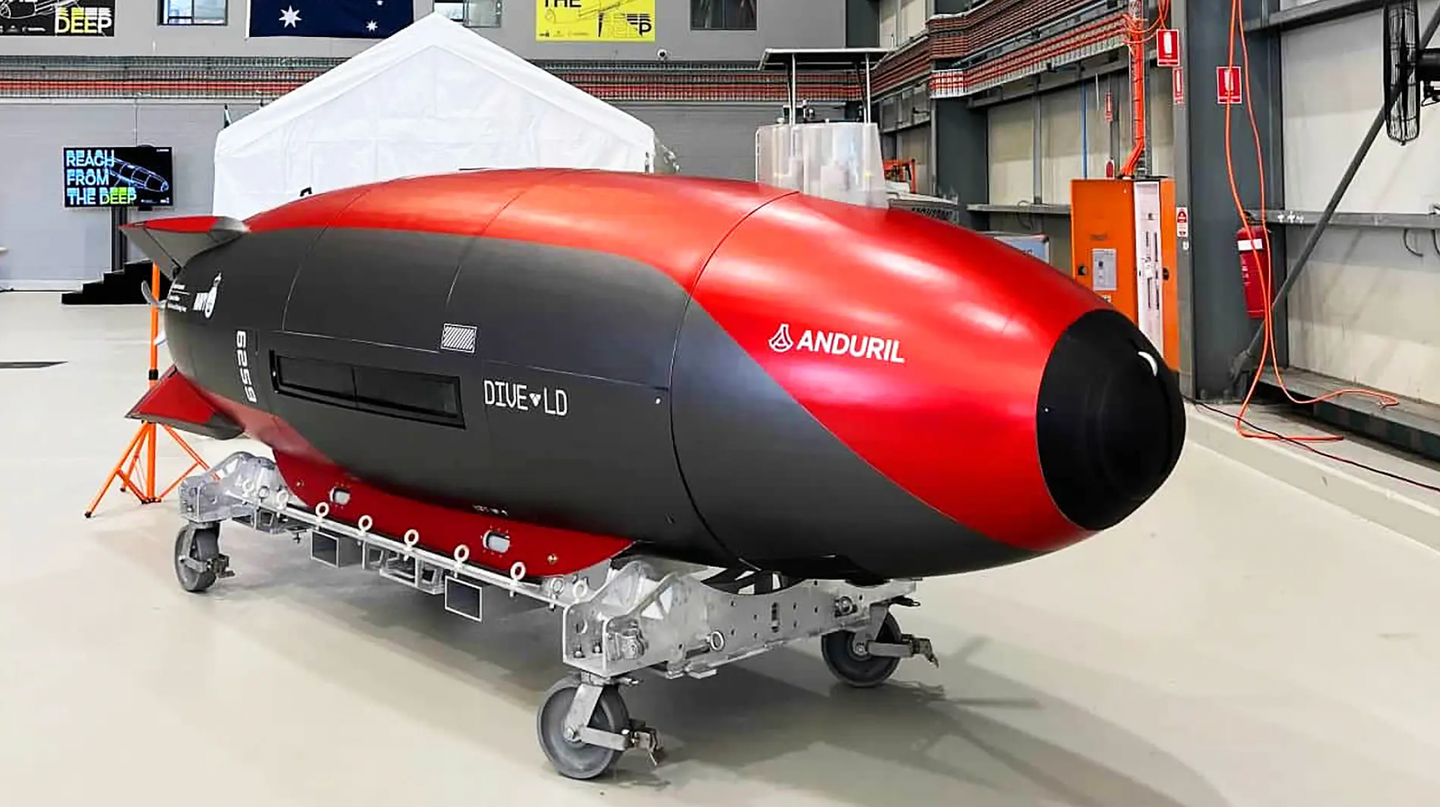
However advanced, hunter-killer submarines are only as effective as the targeting information available to them. By acquiring the SURTASS-E system, the Royal Australian Navy will be in a better position to get the most out of these submarines, as well as greatly enhancing its anti-submarine warfare capabilities in a broader sense.





No comments:
Post a Comment